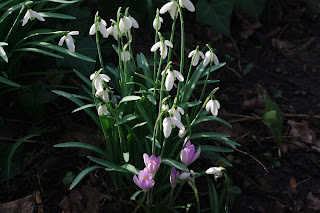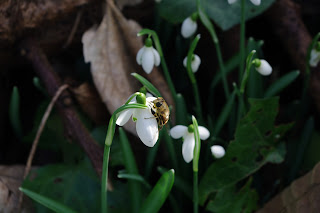A diary of back garden botany, urban ecology, rural rambles and field trips to the middle of nowhere...
Tuesday, 28 February 2017
Narcissus pseudonarcissus is flowering here and there in the garden. Sometimes called the Lent Lily it hasn't waited till Lent this year. It is commonly known as the Wild Daffodil being indigenous to parts of the UK. Actually the bulbs here were grown and supplied from a smallholding in Wales.
When William Wordsworth wrote these words it would have been this species he saw while walking around Ullswater in Cumbria:
"I wandered lonely as a cloud
That floats on high o'er vales and hills,
When all at once I saw a crowd,
A host, of golden daffodils;
Beside the lake, beneath the trees,
Fluttering and dancing in the breeze."
Thursday, 23 February 2017
Crocus tommasinianus -sometimes called the Woodland Crocus- doesn't mind growing in a bit of shade but the flowers only open wide when the sun is on them.
Petite they may be but they provide a beautiful dash of colour early in the season, seeding themselves around and also multiplying by cormlets (i.e. new corms forming on mature corms).
The colours of the petals range from lovely silvery violet to rich plum purple but they all have a bright orange stigma and anthers dusty with pollen. "Tommies" are a magnet for insects braving the cool spring days.
Wednesday, 22 February 2017
Monday, 20 February 2017
A walk through the bare trees of Epping Forest in search of Butcher's Broom. Ruscus aculeatus is quite a rare shrub of ancient woodlands; evergreen with small green flowers in early spring and marble sized red berries in autumn.
I had read that it can be found here, though it certainly isn't common. During the course of several hours walking I found only a few patches of it.
This is a very tough, spiky, spiny plant: so much so that bundles of the stems were indeed used by butchers to sweep and scour their chopping blocks.
Saturday, 18 February 2017
I'm going potty! A few additions to be planted out as spring gets underway. Towards the front of the table there are some recent purchases from the RHS Early Spring Plant Fair: several Lungworts, a few alpines and a saxifrage. Behind them some bulbs potted up last autumn and various seeds in pots left out for winter chilling i.e. stratification to break dormancy.
Along the wall at the back there are pots of Honesty, Red Campion and Foxglove grown from last year's seeds. The yellow flowers poking up under the beanpoles are Winter Aconites (see also my entry below).
Thursday, 16 February 2017
A fine patch of Winter Aconites (Eranthis hyemalis) bathing in the sun on a bank in the village of Charlton in Hertfordshire. One of the earliest flowering spring bulbs they are from southern Europe originally but have naturalised in parts of the UK. They escape from gardens and go native, which is probably the case here.
Having said that I haven't found them to be particularly suited to growing in London. I think the clay soil is too dense for them. In lighter soils the stems unfurl out of the loose earth and the dainty flowerheads nod up to the sky, opening when the sun is on them.
I've walked from nearby Hitchin to Charlton many times. If only the village pub hadn't closed down last year- it's directly opposite the Aconites and I could have had a pint while I gazed out at them.
Tuesday, 14 February 2017
The Ankerwyke Yew is one of Britain's oldest trees. It is estimated to be somewhere between 1500 and 2500 years old. Magna Carta was signed nearby in the year 1215 and it would have been an ancient tree even then. I visited this venerable being on Monday; a half hour train ride out of Clapham Junction and a 20 minute walk from Wraysbury station took me to it.
The tree stands in the grounds of Ankerwyke Priory. A small ruin about 20 paces away is the only remaining piece of the Priory itself (see also my entry below). Many such places and churches have yews growing beside them. It was supposed that the buildings came first and the yews were planted afterwards for symbolic reasons. Researchers into the subject are now suggesting a different scenario.
In some cases the yews pre-date Christianity which suggests it was the presence of the trees which decided the choice of location to be built upon. These may have been sacred places before Christians came to them.
Monday, 13 February 2017
Snowdrops grow in profusion in the grounds of Ankerwyke Priory near Wraysbury in Berkshire. The ruin in the photos is the only surviving chunk of what was once the priory.
Snowdrops may be native to these shores but it is thought more likely they were introduced at some point. Some have suggested the Romans due to the distribution of Galanthus species across Europe and the Middle East.
Another theory (which seems quite plausible) is that they were bought over by Norman monks and nuns. Large colonies are found in and around monastic sites across the country. The snowdrop is associated with Candlemas Day on February 2nd. and as a symbol of the purity of the Virgin Mary.
Wednesday, 8 February 2017
The dank and mysterious Wistman's Wood on Dartmoor. In fact these photos were taken on a visit in August 2012 when I was camping nearby. I was prompted to have another look at the shots I took by a fascinating book I'm reading called "The Rainforests of Britain and Ireland" by Clifton Bain.
Rainforests are usually spoken of as being tropical but there are also temperate rainforests. This book looks at some of the last remaining fragments that exist in our part of the world. They are sometimes referred to as the Celtic or Atlantic rainforests due to their distribution along the west coast of Scotland, western Ireland, Cumbria, Wales and the south-west of England.
Wistman's Wood is one of these. It's so wet on Dartmoor that even the wooden sign pointing the way to the wood is becoming encrusted with lichen. The wood is dominated by stunted oaks that grow among granite boulders and every surface is thick with mosses, lichens and ferns.
I think elves and trolls are probably extinct in the UK but if there are any to be found anywhere they are probably hiding in Wistman's Wood.
Tuesday, 7 February 2017
An early bee on the Snowdrops coming into flower in the garden. They are the first species to flower en masse as late winter gives way to early spring. Even in the first week of February bees come out in search of food if the day is sunny.
A previous occupant of the house must have planted some Snowdrops and they have taken to the far end of the garden, spreading freely over time. I've helped them on their way by dividing off small clumps after flowering and planting them round and about.
Subscribe to:
Comments (Atom)



































